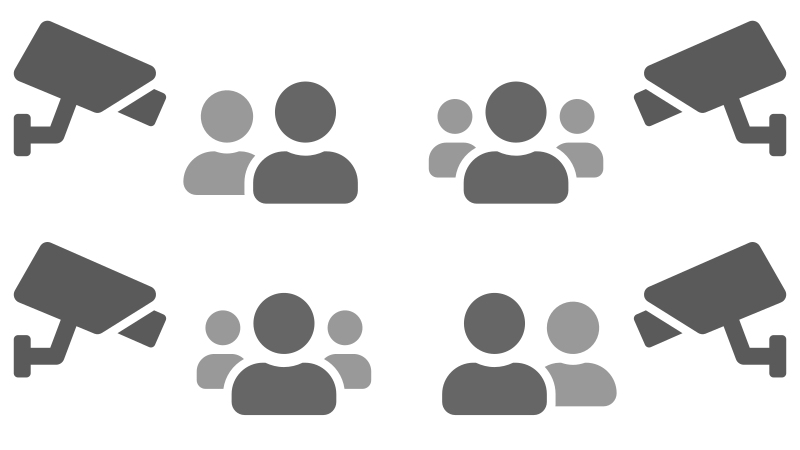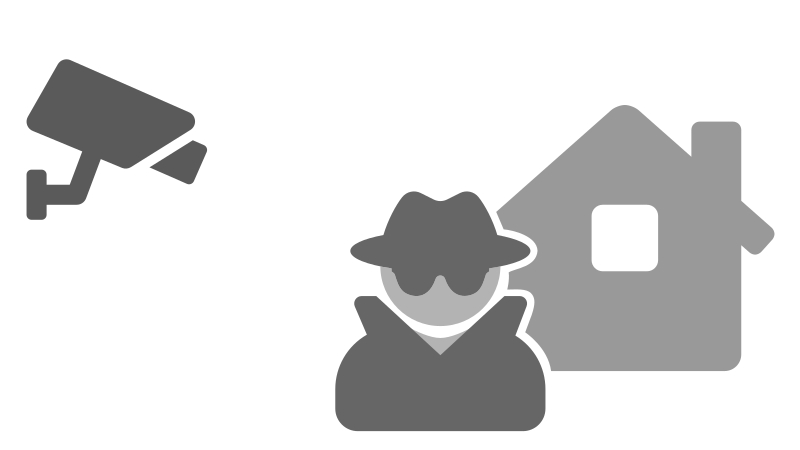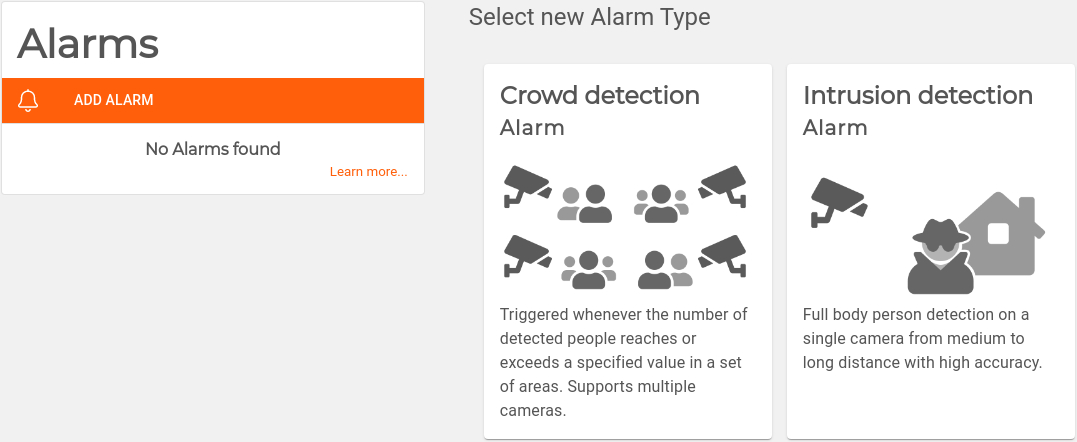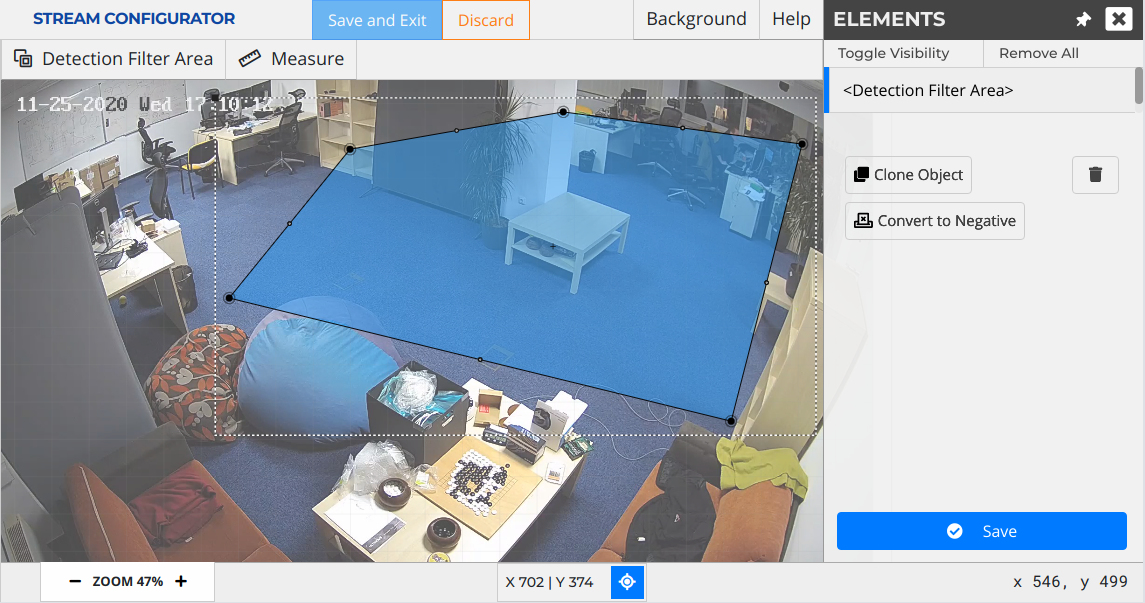Alarms
Alarms are processes for detecting incidents.
Click the Alarms menu on the left sidebar for this view.

Before starting
Please make sure that all Cameras are registered and activated in U-alarm.
Supported Alarms
Crowd detection

A Crowd detection alarm is triggered whenever number of the currently visible people reaches or exceeds a specific number. Multiple cameras can be associated to a single Crowd detection, in this case the sum of the people triggers the alarm. This use case is ideal for detecting the extreme size of a queue or for detecting a potentially dangerous situation in a safety zone.
- Core technology: head detection.
- Areas of interest can be defined on each camera.
- Send alarm notifications to third-party softwares.
- Multi camera support.
Intrusion detection

An Intrusion detection alarm is triggered whenever a person is detected.
- Core technology: full body detection. The detection distance and the accuracy is much higher compared to head detection.
- Areas of interest can be defined.
- Send alarm notifications to third-party softwares.
Create a new alarm
Note: In this version only one type of the alarms can be used at the same time per device.
New Crowd detection

- Click the Add Alarm button.
- Choose Crowd detection by clicking on its box. Fill the form.
- Name: A readable name of this alarm. This name will appear in the Events view and in all notifications.
- Active: A running alarm can be deactivated here. Activated by default.
- Schedule of the alarm (optional): you can associate one of your previously defined Schedules to this alarm.
- Critical number of people: This alarm will be triggered if the sum of the people (considering all associated cameras) reaches or exceeds this number.
- Camera: Check all cameras that should be observed by this alarm. At least one camera should be associated.

- Draw Areas (ROIs) /optional/: Sometimes the alarm should be narrowed to a specific area of the video. If you would like to observe only a specific area it can be determined here. Clicking this button the Stream Configurator graphic editor appears. Without ROIs the entire video will be observed.
- Sensitivity: the sensitivity of the detector can be fine tuned here. Lowering the sensitivity causes less false alarms but decreases the accuracy. Increasing causes more alarms but may cause more false alarms as well.
Cooldown: After a triggered alarm it won't be triggered for the specified duration.
HTTP Client configuration (optional):
Use this feature in order to send triggered events to a third-party software. The following information should be provided by the third-party software's administrator.
- Enable HTTP client: Enables / disables event sending.
- Target url: The location of the API.
- Header key: Key of custom HTTP header.
- Header value: Value of custom HTTP header.
- Trust all certificates: If enabled, HTTPS certification errors will be ignored.
Click the Submit button to save your settings.
New Intrusion detection
- Click the New Alarm button.
- Choose Intrusion detection by clicking on its box. Fill the form.
- Name: A readable name of this alarm. This name will appear in the Events view and in all notifications.
- Active: A running alarm can be deactivated here. Activated by default.
- Schedule of the alarm (optional): you can associate one of your previously defined Schedules to this alarm.
- Camera: Select one camera that should be observed by this alarm

- Draw Areas (ROIs) /optional/: Sometimes the alarm should be narrowed to a specific area of the video. If you would like to observe only a specific area it can be determined here. Clicking this button the Stream Configurator graphic editor appears. Without ROIs the entire video will be observed.
- Sensitivity: the sensitivity of the detector can be fine tuned here. Lowering the sensitivity causes less false alarms but decreases the accuracy. Increasing causes more alarms but may cause more false alarms as well.
Cooldown: After a triggered alarm it won't be triggered for the specified duration.
HTTP Client configuration (optional):
Use this feature in order to send triggered events to a third-party software. The following information should be provided by the third-party software's administrator.
- Enable HTTP client: Enables / disables event sending.
- Target url: The location of the API.
- Header key: Key of custom HTTP header.
- Header value: Value of custom HTTP header.
- Trust all certificates: If enabled, HTTPS certification errors will be ignored.
- Click the Submit button to save your settings.
Edit an existing alarm
- On the left side of the view find and click the existing alarm you would like to modify in the Configured Alarms list.
- Edit your settings just like when this alarm was created.
- Click the Save button.
Delete an existing alarm
- On the left side of the view find and click the existing alarm you would like to modify in the Configured Alarms list.
- Click the Delete button.
Using the Stream Configurator

Basic Navigation
- Zoom with the mouse wheel.
- Pan by dragging the middle mouse button.
Drawing a new Detection Filter Area
Select Detection Filter Area tool from the top toolbar.
Define an area by simply clicking its nodes on the canvas.
- Each step can be undone with a right-click.
- Click on the starting point to finish the area (or double-click the last point).
The new Detection Filter Area Appears in the Elements list.
You can draw more Areas. A video can have unlimited number of Detection Filter Areas.
For most use cases that is enough. Click the Save and Exit button at the top of the screen or cancel all changes with the Discard button.
Negative Areas (optional)
Negative areas can be used when posters, billboards or other design elements contain people and these images cause false alarms. In a Negative Area all detections will be ignored.
- In the Elements list select an existing Detection filter area.
- Click the Convert to Negative button. Clicking the button again will change the area back to positive.
- Click the Save button at the bottom of the Elements box.
- The area is turned to red indicating that it is a Negative Area.
Edit an existing Detection Filter Area
In the Elements list select an existing Detection filter area.
- On the canvas each node of the Area can be moved by mouse-dragging.
- New nodes can be created by clicking on the mid-point of a section of the Area.
- The entire Area can be moved by dragging the black square at the top-left corner of the bounding box.
Click the Save button at the bottom of the Elements box.
Delete an existing Detection Filter Area
- In the Elements list select an existing Detection filter area.
- Click the Trash button.
Other features
Elements
- The list of the created Areas are available here.
- You can hide the Elements box by clicking the X in the top right corner.
- The entire panel can be docked to the right or can be unattached by toggling the Pin button in the top bar.
Background
- The background image can be refreshed.
- The opacity of the background can be changed.
After finished
You are most likely done with all mandatory settings. However you can define Schedules for the alarms if they should not operate all the time. Otherwise you can learn more about receiving Events.
